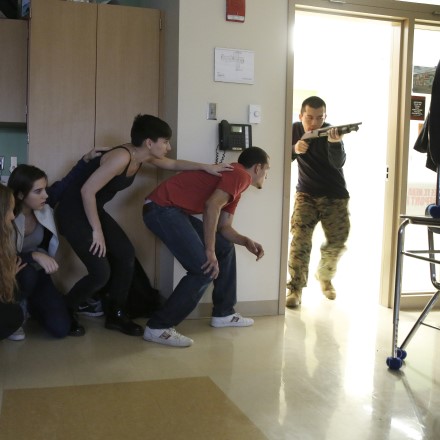Active Shooters & Active Killers

Active Shooter Articles
- School Shootings (Part 1)
- School Shootings (Part 2)
- School Shootings And Islamic Terrorism
- Mass Shootings In The US Versus Knife Crime In The UK
- Active Shooters
- Active Shooter - Run, Hide, Fight (Running)
- Active Shooter (Part 2) - Hide, Fight
- Active Killer Emotions & Motivations
- Active Killers & Suicidal Ideation
- Not All Mass Shootings Are The Same
- Injustice Collectors
- Similarities Between University & Workplace Shootings
- The Ineffectiveness of Various School Policies in Preventing Active Shooter Incidents
- Mass Shootings & America's Violent Holidays
- Mass Shootings in 2023
- Last Resort - A Risk Factor
All Krav Maga Articles
Rampage & Spree Killings
Active Shooter and Active Killer incidents can be categorized according to the locations (and audiences) involved e.g., there may be workplace shootings where an employee, or ex-employee, brings a firearm into the workplace and engages on a killing spree, and there are also school and university shootings where a student goes on a rampage in their school or on a university campus etc. The fact that these two examples of mass killing happen in very different settings, and amongst different demographics (most workplace shootings involve middle-aged men, whilst most university and school shootings/killings are committed by teenagers or those in their early twenties) demonstrates that to understand active shooter events fully, they can’t all be viewed as one and the same. Whilst there might be commonalities what motivates a teenage to kill fellow classmates, may be very different to that which drives a long-time employee – and till that point, one who may never have had a bad word said against them - to bring a gun to work etc. It is also worth noting that those who engage in mass killings as part of a terrorist campaign are doing so to achieve very different goals and outcomes to those engaged in school or workplace shootings. This is why it is vital not to view active shooters as all being cut from the same cloth.
Active shooters and killers usually go through a similar process before they finally engage in their killing spree. The first phase in their thinking will be that of a fantasy i.e., having a satisfying thought about engaging in a shooting or killing spree. Initially this may cause some embarrassment and guilt, and they may try and suppress it. At some point it will become like an itch that they have to scratch, till eventually it consumes them and becomes a need that they can’t ignore. At this stage they will start to mentally plan the event out, which will in turn help feed, develop, and support the fantasy. Certain plans will be discarded as being too complicated etc., but soon a workable plan will develop and when this happens the preparation stage begins. This is when the killer(s) starts to acquire the things that they will need to put the plan into action, such as buying firearms and ammunition etc. The Columbine shooters, Eric Harris and Dylan Klebold, spent over a year practicing bomb making, as their original intent was to emulate the 1995 Oklahoma City Bombings committed by Timothy McVeigh (it was only when their bombs failed to explode did they engage in a shooting spree). They had planned their killing to be on the same day, April 19th, but a school holiday meant they had to postpone it till the 20th. Scheduling a killing rampage to fall on the same day as a previous one is a common planning characteristic of many active shooters and killers. At some point there is often a crisis moment – emotionally or psychologically – where those involved in the planning, who have not set an exact date, feel the need to respond to violently. This is more common in workplace shootings where a disciplinary hearing by supervisors – as was the case with Pat Sherrill who engaged in the 1986 shooting at the Edmonton Post Office where he worked – prompts a violent and deadly reaction.
Once the individual is ready to act, they enter the last two phases: Approach and Implementation. In the case of the Columbine killers both Klebold and Harris, during the approach phase, informed a fellow student Brooks Brown, that he shouldn’t go to school that morning, something that is not uncommon for killers to do e.g., Pat Sherrill told a co-worker that he liked that they shouldn’t come in the next day. Once the implementation stage has begun, the only real solutions left are to: run, barricade, and hide, and/or fight. In some situations, it may be necessary to combine all three. The articles in this section look at different aspects of and solutions to active shooter and killer incidents.
References
Bingham, R., Heath, M., Lyon, R., Williams, M., Whicker, J., & Paine, C. (2009). Memorializing Columbine. Illness, Crisis & Loss 17(3): 223-241.
Brown, B., & Merritt, R. (2002). No Easy Answers: The Truth Behind Death At Columbine. New York, NY: Lantern Books
Oliffe, J., Han, C., Drummond, M., Sta. Maria, E., Bottorff, J., & Creighton, G. (2015). Men, Masculinities, and Murder-Suicide. American Journal of Men's Health 9(6): 473-485.
Tonso, K. (2009). Violent Masculinities as Tropes for School Shooters. American Behavioral Scientist 52(9): 1266-1285.